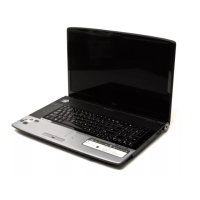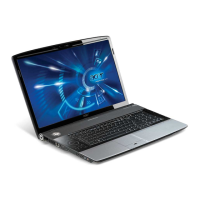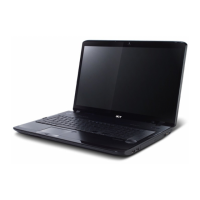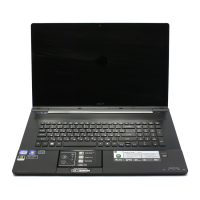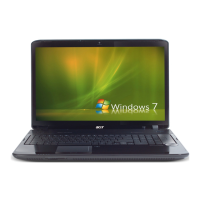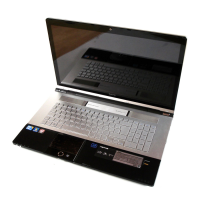What to do if Acer Aspire 8920 has power failure?
- LLindsey DixonJul 26, 2025
If the Acer Laptop experiences a power failure where the power indicator does not turn on or stay on, refer to “Power System Check” on page 81.
What to do if Acer Aspire 8920 has power failure?
If the Acer Laptop experiences a power failure where the power indicator does not turn on or stay on, refer to “Power System Check” on page 81.
What to do if Acer Aspire 8920 Laptop POST detects an error?
If the Acer Laptop's POST detects an error and displays messages on the screen, consult the “Error Message List” on page 85.
What to do if Acer Aspire 8920 Laptop has LCD display problems?
If you are experiencing other symptoms with your Acer Laptop, such as LCD display problems, consult the “Power-On Self-Test (POST) Error Message” on page 84.
What to do if Acer Laptop has intermittent problems?
If you are experiencing intermittent problems with your Acer Laptop that cannot be recreated, use the customer-reported symptoms and refer to “Power-On Self-Test (POST) Error Message” on page 84, “Intermittent Problems” on page 95, and “Undetermined Problems” on page 96.
What to do if Acer Laptop POST does not complete?
If the Acer Laptop's POST does not complete and there are no beeps or error codes, refer to “Power-On Self-Test (POST) Error Message” on page 84 and “Undetermined Problems” on page 96.
Records updates made to the service guide.
Legal notices regarding publication rights and disclaimers.
Explains formatting and symbols used throughout the manual.
Provides general information before using the product and guide.
Details on OS, CPU, chipset, memory, and environment specs.
Covers screen resolution, audio system, storage options, and optical drives.
Lists keyboard, touchpad, webcam, WLAN, and I/O ports.
Graphical representation of the computer's internal component interconnections.
Diagrams showing top/bottom views of motherboard connectors and key components.
Visual guide to the notebook's external features and ports from various views.
Explanation of status indicators, easy-launch buttons, and touchpad basics.
Instructions on using the touchpad and keyboard features, including hotkeys.
Overview of utilities for system management, audio, power, security, and recovery.
Controls audio settings and manages power plans for system efficiency.
Features for data protection, encryption, and system backup/recovery.
System information, health monitoring, and mobile settings access.
Introduces utilities like Bio-Protection for security and GridVista for display management.
Comprehensive details on processor, memory, interfaces, and system board components.
CPU type, cache size, RAM specs, and memory combinations.
LAN, Modem, Bluetooth, HDD, DVD, USB, and Express Card details.
Major chips, keyboard, battery, LCD, inverter, adapter, and power management.
System info, BIOS version, and basic configuration parameters.
Advanced system settings and security options, including password management.
Setting boot priority and saving/discarding BIOS configuration changes.
Steps for updating the system BIOS flash memory for new features or fixes.
Instructions to remove an HDD password if it is locked.
Required tools for disassembly and important safety steps before starting.
Graphical guides for disassembling the main unit and LCM module.
Detailed procedures for removing battery, storage, cooling, CPU, and other parts.
Guides for system checks, error messages, and symptom diagnosis.
Steps for verifying diskette, CD-ROM, keyboard, memory, and power systems.
Lists POST errors, causes, and recommended FRU actions.
Correlates system symptoms to specific hardware components for repair.
Strategies for diagnosing recurring system issues.
Procedures for troubleshooting problems with unclear causes.
Diagrams illustrating top and bottom views of motherboard connectors and jumpers.
Diagrams showing top and bottom views of motherboard connectors and key components.
Comprehensive list of field replaceable units with part numbers and exploded diagrams.
Visual breakdowns of the notebook assemblies with itemized part references.
| Display Size | 18.4 inches |
|---|---|
| Resolution | 1920 x 1080 pixels |
| RAM | Up to 4GB DDR2 |
| Bluetooth | Bluetooth 2.0+EDR |
| Connectivity | Gigabit Ethernet |
| Weight | 4.1 kg (9.04 lbs) |
| Processor | Intel Core 2 Duo |
| Graphics | NVIDIA GeForce 9600M GT |
| Operating System | Windows Vista Home Premium |
| Optical Drive | DVD Super Multi |
| Audio | Dolby Home Theater |
| Battery | 8-cell Lithium-Ion |
| Chipset | Intel PM965 Express |
| Wireless | 802.11a/b/g/n |
| Webcam | 1.3 Megapixel |
| Ports | 4 x USB 2.0, 1 x HDMI, 1 x VGA, 1 x eSATA |
